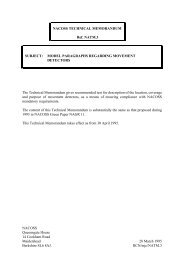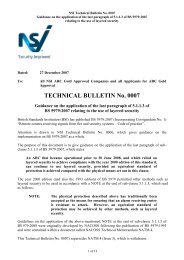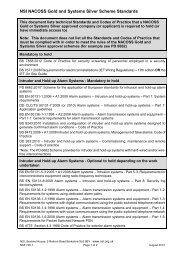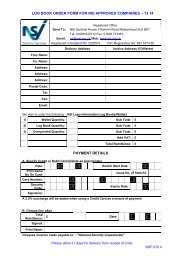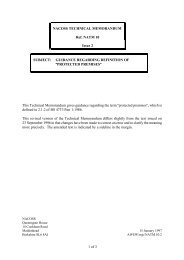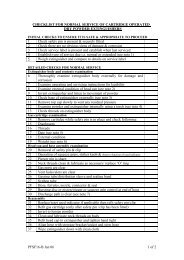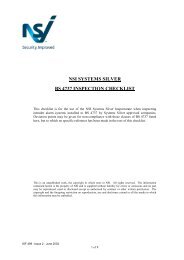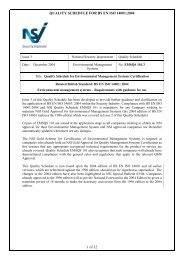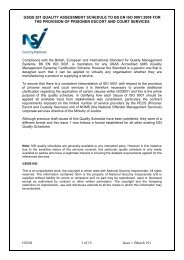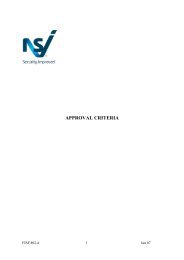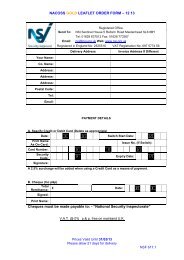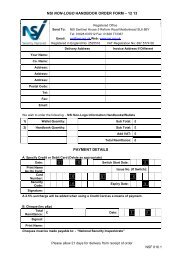National Security Inspectorate Code of Practice for the Planning ...
National Security Inspectorate Code of Practice for the Planning ...
National Security Inspectorate Code of Practice for the Planning ...
You also want an ePaper? Increase the reach of your titles
YUMPU automatically turns print PDFs into web optimized ePapers that Google loves.
<strong>National</strong> <strong>Security</strong> <strong>Inspectorate</strong><br />
NACOSS Gold<br />
<strong>Code</strong> <strong>of</strong> <strong>Practice</strong><br />
<strong>for</strong> <strong>Planning</strong>, Installation<br />
and Maintenance <strong>of</strong><br />
Access Control Systems<br />
NACP 30<br />
This <strong>Code</strong> <strong>of</strong> <strong>Practice</strong> applies to companies holding NACOSS Gold approval<br />
(<strong>for</strong>merly called NACOSS Recognition)
This <strong>Code</strong> <strong>of</strong> <strong>Practice</strong> is to be read in<br />
conjunction with <strong>the</strong> NACOSS Gold<br />
Regulations relating to Approval by NSI and<br />
<strong>the</strong> NACOSS Gold Approval Criteria.<br />
No company shall hold out or claim that it<br />
adheres to this <strong>Code</strong>, save by virtue <strong>of</strong> holding<br />
NSI Approval, or having obtained <strong>the</strong> written<br />
permission <strong>of</strong> NSI<br />
NACP 30<br />
Issue 1<br />
1 December 1990<br />
8 NSI Copyright. No part to be reproduced without permission <strong>of</strong> NSI
<strong>National</strong> <strong>Security</strong> <strong>Inspectorate</strong><br />
<strong>Code</strong> <strong>of</strong> <strong>Practice</strong> <strong>for</strong> <strong>the</strong> <strong>Planning</strong>, Installation and<br />
Maintenance <strong>of</strong> Access Control Systems<br />
LIST OF CONTENTS<br />
PART 1: CODE OF PRACTICE FOR PLANNING AND INSTALLATION<br />
1. SCOPE<br />
2. DEFINITIONS<br />
3. ACCESS POINT CLASSIFICATION<br />
4. SURVEY<br />
5. COMMISSIONING, HANDOVER OF DOCUMENTATION<br />
PART 2: CODE OF PRACTICE FOR MAINTENANCE AND RECORDS<br />
1. SCOPE<br />
2. DEFINITIONS<br />
3. GENERAL MAINTENANCE<br />
4. RECORDS<br />
Note 1: This <strong>Code</strong> <strong>of</strong> <strong>Practice</strong> is in two parts.<br />
Part 1 <strong>of</strong> this <strong>Code</strong> <strong>of</strong> <strong>Practice</strong> aims to assist specifiers, installers, users, insurance companies and<br />
<strong>the</strong> police in selecting <strong>the</strong> level <strong>of</strong> access control equipment best suited to a particular risk and to<br />
provide guidelines <strong>for</strong> <strong>the</strong> planning and installation <strong>of</strong> access control systems.<br />
Part 2 <strong>of</strong> this <strong>Code</strong> <strong>of</strong> <strong>Practice</strong> provides guidelines <strong>for</strong> <strong>the</strong> maintenance <strong>of</strong> access control systems<br />
installed as recommended in Part 1.<br />
Note 2: This <strong>Code</strong> <strong>of</strong> <strong>Practice</strong> is regarded as PROVISIONAL pending publication <strong>of</strong> a British Standard.<br />
Note 3: NACOSS wishes to acknowledge that <strong>the</strong> technical content <strong>of</strong> this <strong>Code</strong> <strong>of</strong> <strong>Practice</strong> is based on<br />
material prepared under <strong>the</strong> auspices <strong>of</strong> <strong>the</strong> British Standards Institution. Such material is used<br />
by permission.<br />
1
In this document, material (such as guidelines, in<strong>for</strong>mation, recommendations, advice) that does not<br />
<strong>for</strong>m a mandatory requirement <strong>of</strong> this <strong>Code</strong> is shown in italics<br />
FOREWORD<br />
An electronic access control system consists <strong>of</strong> recognition equipment, such as a token and reader,<br />
electronically activated entrance release hardware and, in certain systems, means <strong>for</strong> central control and/or<br />
monitoring.<br />
(i)<br />
(ii)<br />
(iii)<br />
(iv)<br />
(v)<br />
(vi)<br />
The objectives <strong>of</strong> this <strong>Code</strong> <strong>of</strong> <strong>Practice</strong> are:<br />
The establishment and maintenance <strong>of</strong> minimum standards <strong>of</strong> installation <strong>for</strong> access control systems.<br />
The provision <strong>of</strong> a framework to assist purchasers, installers, and users in establishing <strong>the</strong>ir<br />
requirements with suppliers.<br />
The assistance <strong>of</strong> specifiers and users in determining <strong>the</strong> appropriate level <strong>of</strong> security required <strong>for</strong> a<br />
given application.<br />
The assistance <strong>of</strong> system designers in meeting specifier <strong>of</strong> user requirements.<br />
The establishment <strong>of</strong> definitions <strong>for</strong> terms used within <strong>the</strong> access control industry.<br />
The establishment <strong>of</strong> minimum standards <strong>of</strong> maintenance <strong>for</strong> installed access controlled systems.<br />
The successful operation <strong>of</strong> an access control system requires <strong>the</strong> active co-operation <strong>of</strong> <strong>the</strong> user in carrying<br />
out <strong>the</strong> necessary procedures carefully and thoroughly. The usefulness <strong>of</strong> <strong>the</strong> whole system and its security<br />
and social acceptability can be jeopardised by lack <strong>of</strong> care. This care has to extend to <strong>the</strong> security <strong>of</strong> tokens<br />
and <strong>of</strong> in<strong>for</strong>mation regarding <strong>the</strong> system, its design, installation and method <strong>of</strong> operation and to ensuring<br />
adequate maintenance, to preserve <strong>the</strong> security <strong>of</strong> access.<br />
Attention is drawn to <strong>the</strong> Regulations <strong>for</strong> Electrical Installations (15th Edition) published by <strong>the</strong> Institution<br />
<strong>of</strong> Electrical Engineers and to MPT1337 and MPT1339 (DTI Radiocommunications Division).<br />
PART 1: CODE OF PRACTICE FOR PLANNING AND INSTALLATION<br />
1. SCOPE<br />
This Part <strong>of</strong> this <strong>Code</strong> <strong>of</strong> <strong>Practice</strong> contains recommendations and requirements <strong>for</strong> <strong>the</strong> selection, planning<br />
and installation <strong>of</strong> electronic access control systems classified by <strong>the</strong> degree <strong>of</strong> security provided.<br />
2. DEFINITIONS<br />
For <strong>the</strong> purposes <strong>of</strong> this <strong>Code</strong> <strong>of</strong> <strong>Practice</strong> <strong>the</strong> following definitions apply:<br />
2.1 Access control system. An electronic system restricting entry into and/or exit from a controlled<br />
area.<br />
2.2 Controlled area. The area accessed by <strong>the</strong> presentation <strong>of</strong> valid recognition data.<br />
2.3 Access point. The position at which access can be controlled by a door, turnstile or o<strong>the</strong>r secure<br />
barrier.<br />
2.4 Access point hardware. Mechanical and/or electro-mechanical devices at an access point<br />
enabling its release by an authorised user.<br />
NOTE: Access point hardware makes no decision regarding <strong>the</strong> permitting or refusal <strong>of</strong> access.<br />
2.5 Access level. User authority in terms <strong>of</strong> access to specified, controlled area.<br />
2.6 Token. A device containing encoded recognition data.<br />
NOTE: This includes a human being as <strong>the</strong> source <strong>for</strong> biometric data.<br />
2.7 Common token. A token unique to a particular access control system, or reader, with all user<br />
tokens identical.<br />
2
2.8 System token. A common token encoded additionally with specific system identification data.<br />
2.9 Unique token. A token which, in addition to any data common to all users <strong>of</strong> a particular access<br />
control system, carried some data allocated uniquely to <strong>the</strong> user <strong>of</strong> that token.<br />
2.10 Keypad. A data entry point <strong>for</strong> <strong>the</strong> input <strong>of</strong> a numeric or alphanumeric code into an access<br />
control system.<br />
2.11 Personal identification number (PIN). A sequence <strong>of</strong> characters allocated to an individual user<br />
<strong>of</strong> an access control system keypad.<br />
2.12 Common code. A sequence <strong>of</strong> characters unique to a particular keypad-operated access control<br />
system and allocated to every user <strong>of</strong> <strong>the</strong> system.<br />
2.13 Reader. Equipment <strong>for</strong> <strong>the</strong> extraction <strong>of</strong> recognition data from a token.<br />
2.14 Biometric system. An access control system using recognition <strong>of</strong> a physiological characteristics<br />
<strong>of</strong> <strong>the</strong> user, such as fingerprints, retinal pattern, voice pattern or signature.<br />
2.15 Transaction. A recognisable event occurring within an access control system, such as <strong>the</strong> release<br />
<strong>of</strong> a door following presentation <strong>of</strong> a valid token or <strong>the</strong> generation <strong>of</strong> a door alarm report.<br />
2.16 Controller. A device which processes recognition data to enable usable output conditions to be<br />
derived.<br />
2.17 Central control. ('on-line') Equipment directing <strong>the</strong> functions <strong>of</strong> a number <strong>of</strong> controllers,<br />
changing data <strong>for</strong> individual controllers and/or monitoring an access control system.<br />
2.18 Time zone. A period <strong>of</strong> time during which system operating requirements are changed, such as<br />
refusal <strong>of</strong> access outside normal working hours or PIN override.<br />
2.19 Fail locked. The securing <strong>of</strong> a locking mechanism in <strong>the</strong> event <strong>of</strong> identified system failures.<br />
2.20 Fail unlocked. The release <strong>of</strong> a locking mechanism in <strong>the</strong> event <strong>of</strong> identified system failures.<br />
2.21 Tamper detection. A means <strong>for</strong> <strong>the</strong> disclosure <strong>of</strong> unauthorized interference with a component <strong>of</strong><br />
an access control system.<br />
3. ACCESS POINT CLASSIFICATION<br />
3.1 General<br />
Access points are classified by <strong>the</strong> requirements <strong>for</strong> successful legitimate access i.e., <strong>the</strong> level <strong>of</strong><br />
security provided. The installing company shall indicate to <strong>the</strong> customer <strong>the</strong> classification <strong>of</strong> <strong>the</strong><br />
access points making up an access control system, related to <strong>the</strong> level <strong>of</strong> security provided.<br />
Facilities to control readers from a central point, to record in<strong>for</strong>mation regarding <strong>the</strong> access <strong>of</strong><br />
individual token holders and to monitor <strong>the</strong> status <strong>of</strong> <strong>the</strong> access point where this is required may<br />
be incorporated into any class <strong>of</strong> access control system.<br />
NOTE: Monitoring, 'access point held open' alarm, cable security and standby power<br />
operation are related to <strong>the</strong> level <strong>of</strong> security provided within a classification.<br />
3.2 Class I - Common code<br />
At an access point to class I, access will only be granted following <strong>the</strong> input <strong>of</strong> a correct common<br />
code. The code shall be numeric, alphabetic, or a combination <strong>of</strong> both, with a minimum <strong>of</strong> four<br />
digits and/or characters. The code used shall be one <strong>of</strong> not less than 1000 differs and shall be<br />
protected against unauthorised change and repeated attempts to select <strong>the</strong> correct code.<br />
3
3.3 Class II - Common token<br />
At an access point to class II, access will only be granted following <strong>the</strong> presentation <strong>of</strong> a valid<br />
common token to a reader and when <strong>the</strong> code within <strong>the</strong> token is recognised by <strong>the</strong> system. Each<br />
token shall have <strong>the</strong> same encoded date chosen from a minimum <strong>of</strong> 10,000 differs. The code shall<br />
be protected against unauthorised change.<br />
3.4 Class III - System token<br />
At an access point to class III, access will only be granted following <strong>the</strong> presentation <strong>of</strong> a valid<br />
system token to a reader. The token shall be encoded with a system code <strong>of</strong> not less than 200<br />
differs and an individual code <strong>of</strong> not less than 10,000 differs. The codes shall be protected against<br />
unauthorised changes.<br />
NOTE 1. Tokens can be added to or deleted from <strong>the</strong> system.<br />
NOTE 2. System tokens should not be acceptable to o<strong>the</strong>r systems in <strong>the</strong> same geographic area<br />
unless specifically intended to be so.<br />
3.5 Class IV - Unique token<br />
At an access point to class IV, access will only be granted following <strong>the</strong> presentation <strong>of</strong> a valid<br />
unique token to <strong>the</strong> reading device. The token shall be encoded with a minimum <strong>of</strong> 10 million<br />
differs. The code shall be protected against unauthorised change.<br />
NOTE: Tokens can be added to or deleted from <strong>the</strong> system.<br />
3.6 Class V - Unique token and PIN<br />
4. PLANNING<br />
At an access point to class V, access will only be granted following <strong>the</strong> presentation <strong>of</strong> a valid<br />
system token (see class IV) and <strong>the</strong> input <strong>of</strong> a correct personal identification number <strong>of</strong> not less<br />
than four characters.<br />
4.1 Survey<br />
The importance <strong>of</strong> a correct and adequate survey <strong>for</strong> installation is paramount.<br />
Access point design has a substantial bearing on <strong>the</strong> per<strong>for</strong>mance and reliability <strong>of</strong> an access<br />
control system and <strong>the</strong> following aspects shall be considered when planning an access control<br />
system.<br />
- Access points shall not conflict with fire regulations and shall not restrict exit in such a way as<br />
to endanger persons in an emergency.<br />
- The operation <strong>of</strong> access points in <strong>the</strong> event <strong>of</strong> mains power failure and <strong>the</strong> period, or number <strong>of</strong><br />
transactions, required in such circumstances.<br />
- Whe<strong>the</strong>r access points should fail locked or fail unlocked.<br />
- The choice <strong>of</strong> access control technology to provide an appropriate level <strong>of</strong> security <strong>for</strong> <strong>the</strong> risk<br />
to be protected.<br />
- The choice <strong>of</strong> electronic equipment and its siting, taking into account environmental conditions<br />
such as wea<strong>the</strong>r and <strong>the</strong> potential <strong>for</strong> vandalism.<br />
- The selection <strong>of</strong> access point hardware, taking into account <strong>the</strong> volume <strong>of</strong> traffic,<br />
environmental conditions and <strong>the</strong> level <strong>of</strong> physical security required.<br />
- The numbers <strong>of</strong> users, access levels and time zones required, taking into account both present<br />
and predicted future levels.<br />
- The need <strong>for</strong> siting <strong>of</strong> equipment such as controllers and printers in a secure area.<br />
- The number <strong>of</strong> access points required, taking into account peak traffic periods.<br />
NOTE: Advice concerning physical security is given in BS 8220.<br />
4.2 Equipment selection and installation<br />
Equipment shall be selected and/or installed to withstand <strong>the</strong> following air temperatures:<br />
4
Internally sited equipment, Oº to 40ºC<br />
Externally sited equipment, -20º to 50ºC.<br />
NOTE: Equipment exposed to direct sunlight can exceed <strong>the</strong>se temperatures and appropriate<br />
shielding may be required in such circumstances. Exterior equipment should be considered <strong>for</strong><br />
use in unheated premises.<br />
Where equipment is exposed it shall meet IP54 or, in a particularly exposed location, IP65 as<br />
specified in BS 5490; necessary apertures in equipment are exempt from <strong>the</strong>se requirements at<br />
such points.<br />
4.2.1 Tokens<br />
The security, size and durability <strong>of</strong> a token is dependent upon <strong>the</strong> technology used to<br />
encode it and required to read it.<br />
Several types <strong>of</strong> token are available including:<br />
(a) magnetic, including Wiegand effect;<br />
NOTE: Where magnetic tokens are powerful enough to corrupt o<strong>the</strong>r magnetically<br />
stored data in <strong>the</strong>ir immediate vicinity <strong>the</strong>y should carry a printed warning to this effect<br />
and limited life cards e.g., those carrying bank data, should not be used as access<br />
control tokens without prior agreement to this by <strong>the</strong> issuing authority.<br />
(b) infra-red;<br />
(c) holograms;<br />
(d) proximity devices using technologies such as radio or induction to allow <strong>the</strong> code to<br />
be read within a specified operating range;<br />
(e) biometric i.e., a specific person or <strong>the</strong>ir signature.<br />
Token technology should be selected appropriately to <strong>the</strong> risk being considered.<br />
The choice <strong>of</strong> size and durability <strong>of</strong> a token and <strong>the</strong> life span <strong>of</strong> a battery powered active<br />
token shall take into account <strong>the</strong> environment in which it will be required to operate and <strong>the</strong><br />
frequency <strong>of</strong> its use.<br />
4.2.2 Readers<br />
A reader or controller and/or its associated access point hardware or a central control shall<br />
provide <strong>the</strong> following features:<br />
- An indication <strong>for</strong> access granted.<br />
- Variable time available <strong>for</strong> access to be made.<br />
- Detection <strong>of</strong> physical tampering and, <strong>for</strong> readers fitted externally, protection against<br />
malicious damage.<br />
- Response within 2 s <strong>of</strong> <strong>the</strong> valid completion <strong>of</strong> <strong>the</strong> necessary entry procedure(s) and relocking<br />
<strong>of</strong> an access point if it is not <strong>the</strong>n used within a predetermined time.<br />
Readers shall be securely mounted in a convenient position <strong>for</strong> <strong>the</strong> user adjacent to <strong>the</strong><br />
access point.<br />
NOTE: Proximity readers may be sited at any point where successful activation will<br />
occur.<br />
4.2.3 Access point hardware<br />
Mechanisms shall be selected in accordance with <strong>the</strong> degree <strong>of</strong> security, related to <strong>the</strong><br />
classification, and <strong>the</strong> anticipated traffic and duty cycle <strong>of</strong> <strong>the</strong> access point to which <strong>the</strong>y<br />
are affixed.<br />
NOTE: Access control hardware alone may not provide sufficient physical security in<br />
5
some circumstances.<br />
Access point hardware shall be carefully selected with regard to <strong>the</strong> following, particularly<br />
when planning to use mechanisms externally.<br />
- Temperature<br />
- Humidity<br />
- Corrosion<br />
- Vibration<br />
- Dust and o<strong>the</strong>r contamination<br />
- Physical abuse<br />
The selection <strong>of</strong> access point hardware shall take account <strong>of</strong> <strong>the</strong> following with respect to<br />
<strong>the</strong> nature <strong>of</strong> <strong>the</strong> access point as follows:<br />
- The existing physical strength <strong>of</strong> <strong>the</strong> access point, such as doors and frames, which<br />
should not be significantly reduced by <strong>the</strong> fitting <strong>of</strong> <strong>the</strong> necessary locking<br />
mechanisms and <strong>the</strong> mechanism should be selected appropriately to <strong>the</strong> strength <strong>of</strong><br />
<strong>the</strong> door frame.<br />
NOTE: The physical strength <strong>of</strong> an access point should be rein<strong>for</strong>ced if this is likely to<br />
be reduced by <strong>the</strong> attachment <strong>of</strong> <strong>the</strong> access control hardware; advice on <strong>the</strong> physical<br />
strength requirements is given in BS 8220.<br />
- The transfer <strong>of</strong> electrical connections onto doors via suitable flexible cables or o<strong>the</strong>r<br />
means <strong>of</strong> adequate reliability.<br />
- Appropriate hardware where rebated and double-rebate doors are controlled.<br />
- Necessary safety precautions where all-glass or o<strong>the</strong>r special doors are controlled.<br />
- Door closing devices shall be sufficient to close and lock <strong>the</strong> door under normal<br />
circumstances, but without undue impact upon <strong>the</strong> components <strong>of</strong> an access control<br />
system.<br />
NOTE: Where adverse air pressure exists means <strong>for</strong> its relief should be provided.<br />
- Doors shall be a satisfactory fit in <strong>the</strong> frame.<br />
- Hinges, frame and fixings shall be adequate <strong>for</strong> <strong>the</strong> weight and proposed usage <strong>of</strong> a<br />
door.<br />
- Manufacturers recommendations <strong>for</strong> turnstiles and similar barriers, and <strong>the</strong>ir<br />
release mechanisms.<br />
- Where manual or automatic override features are used, continuously rated releases will<br />
be required.<br />
Where access point monitoring is <strong>of</strong> critical importance, consideration should be given<br />
to monitoring <strong>the</strong> state <strong>of</strong> securement <strong>of</strong> <strong>the</strong> access point, i.e., closed and locked, in<br />
addition to any monitoring by means <strong>of</strong> a separate protective switch.<br />
Locking mechanisms can have two modes <strong>of</strong> operation under system failure conditions,<br />
'failed unlocked' and 'fail locked'. Where exit is available by purely mechanical means,<br />
<strong>the</strong> fail locked mode may be acceptable but where exit is granted by electrical means,<br />
<strong>the</strong> fail unlocked mode may be mandatory to meet safety legislation.<br />
NOTE: The suitability <strong>of</strong> any proposed access control system should be discussed with<br />
<strong>the</strong> local Fire Prevention Officer and it should be ascertained whe<strong>the</strong>r a central<br />
controller is an acceptable means <strong>of</strong> releasing access points in <strong>the</strong> event <strong>of</strong> an<br />
emergency, i.e., whe<strong>the</strong>r it is acceptable <strong>for</strong> a computer command to carry out this<br />
function.<br />
6
4.2.4 Power supplies<br />
The capacity <strong>of</strong> <strong>the</strong> power supply shall be selected to meet <strong>the</strong> largest load likely to be<br />
placed upon it under normal operational conditions. The operating voltage shall not exceed<br />
50 volts.<br />
NOTE: Certain release mechanisms associated with an access control system, such as<br />
those <strong>for</strong> roller shutters, may operate at mains voltage and specific electrical safety<br />
requirements will apply to <strong>the</strong>se.<br />
Where safety and security considerations do not require continued operation <strong>of</strong> a system<br />
during a mains supply failure, <strong>the</strong> public mains via a safety isolating trans<strong>for</strong>mer may<br />
be <strong>the</strong> sole supply <strong>for</strong> <strong>the</strong> system. A 'clean' source <strong>for</strong> this may be required in<br />
electrically noisy environments.<br />
System power supplies shall be located within <strong>the</strong> controlled area in a position secure from<br />
tampering.<br />
Systems incorporating fail unlocked hardware shall be provided with additional security <strong>for</strong><br />
<strong>the</strong> power supply unit.<br />
The main supply shall be permanently connected via a fused outlet i.e., not by a plug and<br />
socket.<br />
Lower voltage cables shall not be brought into a power supply container through <strong>the</strong> same<br />
entry point as any mains cables.<br />
Where continued operation <strong>of</strong> <strong>the</strong> system is essential during mains supply failure, a<br />
standby power supply shall be used having <strong>the</strong> necessary capacity to support <strong>the</strong> system <strong>for</strong><br />
not less than <strong>the</strong> minimum period required by <strong>the</strong> customer.<br />
4.2.5 Cables<br />
4.3 Control<br />
4.2.5.1 Where practicable, cables shall be installed within a controlled area.<br />
Where practicable, cables should be concealed.<br />
Where cables are exposed to possible mechanical damage or tampering, or are in<br />
public areas, <strong>the</strong>y shall be protected by suitable conduit, trunking, or armour.<br />
Where an access point release signal passes outside <strong>of</strong> a controlled area, metal<br />
conduit (or equivalent protection) shall be used.<br />
All interconnecting wiring shall be supported and its installation shall con<strong>for</strong>m<br />
to good working practice.<br />
Any cable joints shall be made in suitable junction boxes using ei<strong>the</strong>r wrapped,<br />
soldered, crimped, or screw-terminals.<br />
Low voltage and signal cables shall not run in close proximity to mains or o<strong>the</strong>r<br />
transient carrying cables.<br />
4.2.5.2 Signal cables <strong>for</strong> <strong>the</strong> transmission <strong>of</strong> data or o<strong>the</strong>r low level signals shall be <strong>of</strong> a<br />
type and size compatible with <strong>the</strong> rate <strong>of</strong> data transfer and anticipated levels <strong>of</strong><br />
electromagnetic interference.<br />
4.2.5.3 Cables should be installed in accordance with IEE Regulations <strong>for</strong> Electrical<br />
Installations.<br />
4.2.5.4 Low voltage cables from both mains and standby power supplies to remote<br />
equipment shall be <strong>of</strong> sufficient size to permit satisfactory operation <strong>of</strong> <strong>the</strong><br />
equipment at <strong>the</strong> end <strong>of</strong> any proposed length <strong>of</strong> cable run.<br />
In selecting controls, consideration shall be given to <strong>the</strong> following:<br />
- Operational requirements <strong>of</strong> <strong>the</strong> associated controllers.<br />
7
- Protection against unauthorised interference with <strong>the</strong> system database or programme.<br />
- Logging <strong>of</strong> transactions.<br />
- Annunciation <strong>of</strong> alarms.<br />
- Blocking, validation and deletion <strong>of</strong> tokens.<br />
- Database <strong>for</strong> <strong>the</strong> retention <strong>of</strong> token holder details with back-up copies <strong>of</strong> corruptible data to<br />
facilitate re-establishment <strong>of</strong> <strong>the</strong> system in <strong>the</strong> event <strong>of</strong> a failure.<br />
- Programming <strong>of</strong> access levels and time zones.<br />
- Period <strong>of</strong> operation following mains failure and/or storage <strong>of</strong> data by non-volatile means.<br />
- Maintenance and serviceability.<br />
Control may be by means <strong>of</strong> a proprietary computer.<br />
The manufacturer's specified environmental conditions shall be provided, particularly in respect <strong>of</strong>:<br />
- Temperature<br />
- Humidity<br />
- Dust and o<strong>the</strong>r air contamination<br />
- Vibration<br />
- Electromagnetic interference<br />
The following shall be taken into consideration when siting control equipment:<br />
- Ventilation<br />
- Access <strong>for</strong> maintenance<br />
- User access <strong>for</strong> archiving etc.<br />
- Noise from associated printer<br />
- Physical security and supervision<br />
- General visibility to unauthorized persons <strong>of</strong> any displayed data.<br />
5. COMMISSIONING, HANDOVER AND DOCUMENTATION<br />
5.1 Commissioning<br />
Commissioning shall include testing <strong>of</strong> <strong>the</strong> following aspects <strong>of</strong> <strong>the</strong> system:<br />
- All wiring is correctly terminated.<br />
- Voltage and resistance at all appropriate points <strong>of</strong> <strong>the</strong> system, which shall be recorded.<br />
- Correct alignment and operation <strong>of</strong> access point hardware and <strong>of</strong> release and closure mechanisms<br />
at each access point.<br />
- Correct operation <strong>of</strong> each reader.<br />
- Release time <strong>for</strong> each door.<br />
- Door held open signal, if specified.<br />
- Verification <strong>of</strong> access levels, where specified, by <strong>the</strong> input <strong>of</strong> appropriate data.<br />
- Ensure system continues to work when mains supply disconnected (if specified).<br />
5.2 Handover<br />
At handover, <strong>the</strong> installing company shall:<br />
8
- Provide a system log book to <strong>the</strong> customer and explain how to record/report problems.<br />
- Demonstrate all aspects <strong>of</strong> <strong>the</strong> system operation to <strong>the</strong> customer, including any necessary safety<br />
precautions.<br />
- Ensure that <strong>the</strong> correct documentation (see 5.3) is given to <strong>the</strong> customer to enable to system to be<br />
operated, adjusted and maintained.<br />
- Train <strong>the</strong> system user(s) in its correct operation and arrange <strong>for</strong> any fur<strong>the</strong>r necessary training.<br />
- Ensure that users know <strong>the</strong> procedure <strong>for</strong> summoning assistance in <strong>the</strong> event <strong>of</strong> system<br />
malfunction.<br />
- Instruct <strong>the</strong> customer to establish whe<strong>the</strong>r personal in<strong>for</strong>mation held within <strong>the</strong> system requires<br />
registration under <strong>the</strong> Data Protection Act.<br />
5.3 Documentation<br />
Upon completion <strong>of</strong> installation <strong>of</strong> <strong>the</strong> access control system <strong>the</strong>re shall be a system record which<br />
shall include <strong>the</strong> following in<strong>for</strong>mation:<br />
(a)<br />
(b)<br />
(c)<br />
(d)<br />
(e)<br />
(f)<br />
(g)<br />
(h)<br />
(i)<br />
<strong>the</strong> name, address and telephone number <strong>of</strong> <strong>the</strong> controlled premises;<br />
<strong>the</strong> name, address and telephone number <strong>of</strong> <strong>the</strong> customer;<br />
<strong>the</strong> location and classification <strong>of</strong> each access point and <strong>the</strong> type and location <strong>of</strong> each controller<br />
and its associated hardware;<br />
<strong>the</strong> type and location <strong>of</strong> power supplies;<br />
details <strong>of</strong> those access points which <strong>the</strong> customer has <strong>the</strong> facility to isolate;<br />
<strong>the</strong> type and location <strong>of</strong> any warning device;<br />
details and settings <strong>of</strong> any preset or adjustable controls incorporated into <strong>the</strong> system;<br />
any documentation relating to equipment;<br />
<strong>the</strong> number <strong>of</strong> keys, codes, tokens, etc. to <strong>the</strong> system provided to <strong>the</strong> customer.<br />
The system record shall be agreed with, and authorized by, <strong>the</strong> customer and a copy provided to <strong>the</strong><br />
customer.<br />
NOTE 1. Some <strong>of</strong> <strong>the</strong> in<strong>for</strong>mation required <strong>for</strong> <strong>the</strong> system record may be provided by means <strong>of</strong> a<br />
diagram <strong>of</strong> <strong>the</strong> installed system.<br />
NOTE 2. All documentation referring to a system should be kept in a place access to which is<br />
restricted to authorized persons.<br />
9
PART 2: CODE OF PRACTICE FOR MAINTENANCE AND RECORDS<br />
1. SCOPE<br />
This Part <strong>of</strong> this <strong>Code</strong> <strong>of</strong> <strong>Practice</strong> contains recommendations and requirements <strong>for</strong> <strong>the</strong> preventative and<br />
corrective maintenance <strong>of</strong>, and keeping <strong>of</strong> records <strong>for</strong>, access control systems, installed in accordance<br />
with Part 1 <strong>of</strong> this <strong>Code</strong>.<br />
2. DEFINITIONS<br />
For <strong>the</strong> purposes <strong>of</strong> this Part <strong>of</strong> this <strong>Code</strong> <strong>of</strong> <strong>Practice</strong> <strong>the</strong> definitions given in Part 1 apply, toge<strong>the</strong>r with<br />
<strong>the</strong> following definitions.<br />
2.1 Maintenance<br />
2.1.1 Maintenance company. An organisation prepared to maintain an installed system.<br />
2.1.2 Preventative maintenance. Routine servicing <strong>of</strong> a system, carried out on a scheduled<br />
basis.<br />
2.1.3 Corrective maintenance. Emergency servicing <strong>of</strong> a system, or part <strong>the</strong>re<strong>of</strong>, carried out in<br />
response to <strong>the</strong> development <strong>of</strong> a fault.<br />
2.2 Commissioning. The completion <strong>of</strong> installation and final testing <strong>of</strong> a system prior to its<br />
handover.<br />
3. MAINTENANCE<br />
3.1 General<br />
3.1.1 It is advisable that maintenance should be carried out by <strong>the</strong> installing company.<br />
Whatever arrangements are made, <strong>the</strong> maintenance company shall have <strong>the</strong> means,<br />
including spare parts and documentation (see 5.3 <strong>of</strong> Part 1), to comply with this Part (Part<br />
2) <strong>of</strong> this <strong>Code</strong>.<br />
NOTE: This recommendation does not place an obligation upon customers who<br />
purchase <strong>the</strong>ir systems to have <strong>the</strong>m maintained by <strong>the</strong> installing company; maintenance<br />
is a matter <strong>of</strong> agreement between <strong>the</strong> customer and <strong>the</strong> installing company or a separate<br />
maintenance company.<br />
3.1.2 The preservation <strong>of</strong> security within <strong>the</strong> maintenance company is <strong>of</strong> paramount importance<br />
and steps shall be taken to ensure <strong>the</strong> safe custody <strong>of</strong> all equipment and documentation<br />
pertaining to installations. A maintenance company shall ensure that adequate vetting <strong>of</strong><br />
employees is carried out and that all employees carry identification cards which shall<br />
include a photograph <strong>of</strong> <strong>the</strong> bearer, his signature, <strong>the</strong> company's name and a date <strong>of</strong> expiry.<br />
3.1.3 Each service technician employed by <strong>the</strong> maintenance company shall carry a range <strong>of</strong> tools,<br />
test instruments and o<strong>the</strong>r equipment to enable him to per<strong>for</strong>m his functions satisfactorily.<br />
Specialist tools, test equipment and plant shall be available <strong>for</strong> deeper investigation as<br />
necessary.<br />
NOTE: Not all eventualities can be <strong>for</strong>eseen and, in exceptional circumstances, a system<br />
or part(s) <strong>of</strong> a system may have to be left inoperable or disconnected whilst tools or<br />
replacement components are obtained (see 4.6).<br />
3.1.4 The maintenance company's organisation shall be so staffed as to ensure that <strong>the</strong><br />
recommendations and requirements <strong>of</strong> this Part <strong>of</strong> this <strong>Code</strong> can be met at all times. The<br />
following factors shall be taken into consideration:<br />
(a) <strong>the</strong> number <strong>of</strong> installations to be serviced;<br />
(b) <strong>the</strong> complexity <strong>of</strong> <strong>the</strong> installations;<br />
(c) <strong>the</strong> geographical spread <strong>of</strong> <strong>the</strong> installations in relation to <strong>the</strong> location <strong>of</strong> <strong>the</strong> maintenance<br />
company, its branches and its service personnel;<br />
(d) <strong>the</strong> method <strong>of</strong> calling out service personnel outside normal <strong>of</strong>fice hours.<br />
3.1.5 Service personnel shall be adequately trained and training shall be updated whenever<br />
10
appropriate.<br />
3.2 Preventative maintenance<br />
3.2.1 Frequency <strong>of</strong> visits<br />
Preventative maintenance visits to <strong>the</strong> protected premises shall be made by a<br />
representative <strong>of</strong> <strong>the</strong> maintenance company during or be<strong>for</strong>e <strong>the</strong> twelfth calendar month<br />
following <strong>the</strong> month <strong>of</strong> commissioning or <strong>of</strong> <strong>the</strong> previous preventative maintenance<br />
visit.<br />
NOTE: The mechanical components in an access control system such as locks and<br />
hinges will require routine preventative maintenance by <strong>the</strong> user more frequently<br />
than once per year.<br />
3.2.2 Inspection<br />
3.3 Corrective maintenance<br />
4. RECORDS<br />
3.2.2.1 During each preventative maintenance visit, inspection <strong>of</strong> <strong>the</strong> following, with<br />
all necessary tests, and those rectifications which are practical at <strong>the</strong> time,<br />
shall be carried out:<br />
(a) <strong>the</strong> installation, location and siting <strong>of</strong> all equipment and devices against<br />
<strong>the</strong> system record (see 4.2);<br />
(b) <strong>the</strong> satisfactory operation <strong>of</strong> all equipment;<br />
(c) all flexible connection;<br />
(d) <strong>the</strong> normal and standby power supplies, <strong>for</strong> correct functioning;<br />
(e) <strong>the</strong> control equipment, in accordance with company procedure;<br />
(f) <strong>the</strong> operation <strong>of</strong> any warning device in <strong>the</strong> system.<br />
3.2.2.2 Those items <strong>of</strong> inspection and rectification which are not carried out during<br />
<strong>the</strong> preventative maintenance visit shall be completed within a period <strong>for</strong> 21<br />
days.<br />
3.2.2.3 Those parts <strong>of</strong> a system or any environmental conditions which are found<br />
during preventative maintenance to be <strong>the</strong> potential cause <strong>of</strong> reduce security,<br />
shall be identified on <strong>the</strong> maintenance visit record (see 4.4).<br />
3.3.1 An emergency service shall be available and <strong>the</strong> client shall be kept in<strong>for</strong>med <strong>of</strong> <strong>the</strong><br />
address and telephone number <strong>of</strong> <strong>the</strong> maintenance company's emergency service facility.<br />
3.3.2 The emergency service facility shall be so located and organised that, except under<br />
abnormal circumstances, <strong>the</strong> maintenance company's representative reaches <strong>the</strong> controlled<br />
premises within <strong>the</strong> period agreed to in writing by <strong>the</strong> client.<br />
4.1 General<br />
The maintenance company shall establish, retain and maintain a system <strong>of</strong> records relating to <strong>the</strong><br />
system including <strong>the</strong> in<strong>for</strong>mation required by 4.2 to 4.6. It is essential that <strong>the</strong>se records be<br />
protected from unauthorised access.<br />
NOTE: Attention is drawn to <strong>the</strong> Data Protection Act, 1984 in those cases where records<br />
contain in<strong>for</strong>mation concerning individuals.<br />
4.2 System record<br />
A system record will have been generated at installation and may include previous in<strong>for</strong>mation<br />
from <strong>the</strong> system design specification, as well as that required by 5.3 <strong>of</strong> Part 1. This shall be kept<br />
up to date and shall be available to <strong>the</strong> maintenance technician <strong>for</strong> each maintenance visit.<br />
NOTE:<br />
The system in<strong>for</strong>mation as required by Part 1 may be provided in diagram <strong>for</strong>m.<br />
11
4.3 Historical record<br />
A historical record with <strong>the</strong> date <strong>of</strong> every visit, any faults found and <strong>the</strong> action taken shall be kept.<br />
Details <strong>of</strong> every fault reported to <strong>the</strong> maintenance company shall be included, toge<strong>the</strong>r with<br />
details <strong>of</strong> any action taken, and, if known, <strong>the</strong> cause.<br />
This in<strong>for</strong>mation shall be kept <strong>for</strong> at least 2 years after <strong>the</strong> last event to which it refers.<br />
4.4 Preventative maintenance record<br />
The results <strong>of</strong> a preventative maintenance inspection shall be entered on a maintenance visit<br />
record and <strong>the</strong> signature <strong>of</strong> <strong>the</strong> client or his representative obtained on <strong>the</strong> record. A copy <strong>of</strong> <strong>the</strong><br />
record shall be given to <strong>the</strong> client.<br />
This in<strong>for</strong>mation shall be kept <strong>for</strong> at least 15 months after <strong>the</strong> inspection to which it refers.<br />
4.5 Corrective maintenance record<br />
There shall be a record <strong>of</strong> <strong>the</strong> date and time <strong>of</strong> receipt <strong>of</strong> each request <strong>for</strong> emergency service,<br />
toge<strong>the</strong>r with <strong>the</strong> date and time <strong>of</strong> completion <strong>of</strong> corrective maintenance and <strong>the</strong> necessary<br />
action(s) carried out.<br />
This in<strong>for</strong>mation shall be kept <strong>for</strong> at least 2 years after <strong>the</strong> emergency call to which it refers.<br />
The result <strong>of</strong> a corrective maintenance inspection shall be entered on a maintenance visit record<br />
and <strong>the</strong> signature <strong>of</strong> <strong>the</strong> client or his representative obtained on <strong>the</strong> record. A copy <strong>of</strong> <strong>the</strong> record<br />
shall be given to <strong>the</strong> client.<br />
This in<strong>for</strong>mation shall be kept <strong>for</strong> at least 15 months after <strong>the</strong> inspection to which it refers.<br />
NOTE: If a preventative maintenance inspection is made at <strong>the</strong> same time as <strong>the</strong> corrective<br />
maintenance visit, separate visit records should be completed.<br />
4.6 Temporary disconnection record<br />
There shall be a record <strong>of</strong> any temporary disconnection <strong>of</strong> <strong>the</strong> system or <strong>of</strong> any component part(s)<br />
<strong>of</strong> it. This shall identify which part(s) <strong>of</strong> <strong>the</strong> system and <strong>the</strong> associated equipment is not operable.<br />
The reason <strong>for</strong> <strong>the</strong> disconnection and <strong>the</strong> date and time <strong>of</strong> disconnection and <strong>of</strong> subsequent<br />
reconnection shall be given. A signed authorization <strong>for</strong> each disconnection shall be obtained from<br />
<strong>the</strong> client or his representative.<br />
This authorization shall be kept <strong>for</strong> at least 3 months after reconnection.<br />
12
<strong>National</strong> <strong>Security</strong> <strong>Inspectorate</strong><br />
Sentinel House, 5 Re<strong>for</strong>m Road<br />
Maidenhead, Berkshire SL6 8BY<br />
Telephone: 0845 006 3003 Fax: 01628 773367<br />
E-mail: nsi@nsi.org.uk<br />
Web: www.nsi.org.uk



